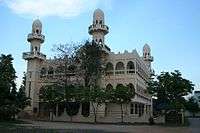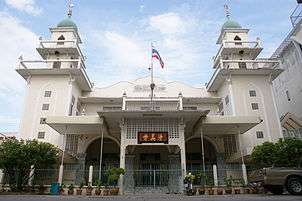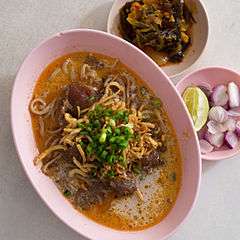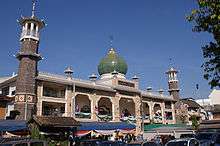Islam in Thailand
Islam is a minority faith in Thailand, with statistics suggesting 4.9 percent of the population are Muslim.[1][2] Figures as high as 5 percent of Thailand's population have also been mentioned.[3][4][5] Most Thai Muslims are Sunnis, although Thailand has a diverse population that includes immigrants from around the world.[6][7]

Demographics and geography
Popular opinion seems to hold that a vast majority of the country's Muslims are found in the Thailand's four southernmost provinces of Satun, Yala, Pattani and Narathiwat, where they make up majority of the population.[8] However, the Thai Ministry of Foreign Affairs' research indicates that only 18 percent of Thai Muslims live in those three provinces. The rest are scattered throughout Thailand, with the largest concentrations being in Bangkok and throughout the southern region.
According to the National Statistics Office, in 2005, Muslims in Southern Thailand made up 30.4 percent of the general population above the age 15, while less than three percent in other parts of the country.[9]
History
In early modern Thailand, Muslims from the Coromandel Coast served as eunuchs in the Thai palace and court.[10][11] Thailand, as Siam, was known for religious tolerance, and there were Muslims working for the Siamese Royal Governments throughout the eras. This culture of tolerance in Siam and later Thailand resulted in the great diversity of Islam in Thailand.
Malay separatism in South Thailand is mostly a war based on ethnicity, as Malays in the region have sought to separate from Thailand, although extremist Muslim groups are involved in the conflict.
Ethnicity and identity

Thailand's Muslim population is diverse, with ethnic groups having migrated from as far as China, Pakistan, India, Cambodia, Bangladesh, Malaysia, and Indonesia, as well as including ethnic Thais, while about two-thirds of Muslims in Thailand are Thai Malays.[12]
Indigenous Thai
Many Thai Muslims are ethnically and linguistically Thai, who are either hereditary Muslims, Muslims by intermarriage, or recent converts to the faith. Ethnic Thai Muslims live mainly in the central and southern provinces - varying from entire Muslim communities to mixed settlements.[13]
Former Commander-in-Chief of the Royal Thai Army General Sonthi Boonyaratglin is an example of an indigenous Thai Muslim. Sonthi is of remote Persian ancestry. His ancestor, Sheikh Ahmad of Qom,[14][15] was an Iranian expatriate trader who lived in the Ayutthaya Kingdom for 26 years. Many Thais, including those of the Bunnag[16] and Ahmadchula families trace their ancestry back to him. Sri Sulalai was a princess of the royal family of the Sultanate of Singora. Rama II of Siam took her as a concubine.
In 1946 Prince Bhumibol Adulyadej and Ananda Mahidol, Rama VIII, toured the Tonson Mosque.[17]
Malay Muslims
.jpg)
In the three southernmost border provinces, the vast majority of the local Muslim population is predominantly Malay, amounting to about 80 percent of the region's population.[18] Thai Malays speak Kelantan-Pattani Malay, which is in a different language from the Malay language.[19] This adds to the culturally unique identity of Thai Malay Muslims.
The high number of Malay origin inhabitants in the southern region is due to the historical nature of the area, which contains parts of the Pattani Kingdom, an Islamic Malay kingdom established in the 19th century, but later annexed to Siam since the early Ayutthaya Kingdom.[20] Similarly, there is an ethnic Thai minority in northern Malaysia.
Chinese Muslims


In the far north, as well as in select central and southern urban areas, there are pockets of Thai Muslims of Hui (ethnic Chinese Muslim) origin.[21][22] Most Chinese Muslims belong to a group of people called Chin Haw in Thai, although most Chin Haw are not Muslims. Some historians believe that the name Chin Haw can be explained to be a combination of "Chin" (China) and "Ho" (Hui). The Chin Haw thus can be seen as traders and émigrés who carried with them Hui traditions from China. One of the best known Chinese mosques is Ban Ho Mosque in Chiang Mai Province.
Muslim groups
Ethnic groups including the Rohingya are found in Thailand's refugee camps, rural fishing villages, as well as in many small towns and cities close to the Myanmar border.
As well as being home to many Chinese Muslims, Northern Thailand is home to many Burmese and mixed Chinese-Burmese or Pakistani-Burmese peoples.
Other Asian Muslim groups
Other represented groups include Muslim Chams, originally from Vietnam since 15th century, who can be found between the mutual border and Bangkok as well as the deep south. In the 1700s and 1800s Vietnam and Cambodia-based Chams settled in Bangkok.[23]
Other groups include South Asians (especially Indians, Pakistanis and Bangladeshis) and Indonesian Muslims, especially Bugis, Javanese and Minangkabau.
According to a 1685 account of a Persian diplomat as well as notes of the French traveller Guy Tachard, there was a substantial Persian Shi'i community in Thailand at the time, with ritual ta'zieh performances subsidised by the king.[24]
Distinctiveness of Thai Islam
_in_Koh_Lanta%2C_Thailand.jpg)
Generally believers of the Islamic faith in Thailand follow certain customs and traditions associated with traditional Islam influenced by Sufism.
For Thai Muslims, like their co-coreligionists in Southeast Asia's other Buddhist-majority countries, Mawlid is a symbolic reminder of the historical presence of Islam in the country. It is also represents an annual opportunity to reaffirm Muslims' status as Thai citizens and their allegiance to the monarchy.[25]
The Islamic faith in Thailand, often reflects Sufi beliefs and practices, as in other Asian countries like Bangladesh, India, Pakistan, Indonesia and Malaysia. The Ministry of Culture's Islamic Department gives awards to Muslims who have contributed to the promotion and development of Thai life in their roles as citizens, as educators and as social workers. In Bangkok, the Ngarn Mawlid Klang main festival is a vibrant showcase for the Thai Muslim community and their lifestyles.[25][26]
Places of worship
According to the National Statistics Office of Thailand in 2007, the country had 3494 mosques, with the largest number, 636, in Pattani Province.[27] According to the Religious Affairs Department (RAD), 99 percent of the mosques are associated with Sunni Islam with the remaining one percent Shi'i Islam.
Governance and education

Chularatchamontri (จุฬาราชมนตรี) is the title of Shaykh al-Islām in Thailand. The title was first used in the Ayutthaya Kingdom when King Songtham (1611–1628) appointed Sheikh Ahmad to the office. Pursuant to the current Islamic Organ Administration Act, BE 2540 (1997), Chularatchamontri is appointed by the king upon advice of the prime minister. He has the authority to administer all Islamic affairs in the nation and to provide advice on Islamic affairs to governmental agencies. Chularatchamontri vacates his office upon death, resignation and removal by the king upon the advice of the prime minister.
There is also a Central Islamic Council of Thailand (คณะกรรมการกลางอิสลามแห่งประเทศไทย) (CICOT) (กอท.), consisting of at least five councillors appointed by the king. The CICOT advises the Minister of Education and the Minister of Interior on Islamic matters. Its presiding officer is Chularatchamontri. Provincial Islamic Councils (คณะกรรมการอิสลามประจำจังหวัด) exist in the provinces that had substantial Muslim minorities. There are other links between the government and the Muslim community, including government financial assistance to Islamic education institutions, assistance with construction of some of the larger mosques, and the funding of pilgrimages by Thai Muslims to Mecca, both Bangkok and Hat Yai being primary gateway cities.
Thailand also maintains several hundred Islamic schools at the primary and secondary levels, as well as Islamic banks, including the Islamic Bank of Thailand, shops and other institutions. Much of Thailand's packaged food is tested and labelled halal if applicable.
See also
References
- Thailand Archived 3 July 2015 at the Wayback Machine, The World Factbook.
- "US Department of State, Thailand". State.gov. Retrieved 25 April 2010.
- "Thailand's southern insurgency: No end in sight". The Economist. 2 January 2016. Retrieved 3 January 2016.
- Joseph, Suad; Naǧmābādī, Afsāna, eds. (2003). Encyclopedia of Women and Islamic Cultures: Family, Law and Politics (illustrated ed.). BRILL. p. 353. ISBN 9789004128187.
- Raghavan, Chitra; Levine, James P., eds. (2012). Self-determination and Women's Rights in Muslim Societies. University Press of New England. p. 171. ISBN 9781611682809.
- Archived 31 December 2010 at the Wayback Machine
- "thai2arab.com". thai2arab.com. Archived from the original on 13 February 2012. Retrieved 2 December 2013.
- "Muslim in Thailand". Retrieved 2 November 2012.
- "สรุปผลการสํารวจการเข??ารวมก ?? จกรรมทางว ิ ัฒนธรรม พ.ศ. 2548" (PDF). Service.nso.go.th. Retrieved 2 December 2013.
- Peletz (2009), p. 73 Gender Pluralism: Southeast Asia Since Early Modern Times, p. 73, at Google Books
- Peletz (2009), p. 73 Gender Pluralism: Southeast Asia Since Early Modern Times, p. 73, at Google Books
- "Thailand". Lcweb2.loc.gov. Retrieved 2 December 2013.
- Gilquin, Michel (2002). The Muslims of Thailand. IRASEC (Silkworm Books). ISBN 974-9575-85-7.
- "ŕ¸Šŕ¸ľŕ¸§ŕ¸´ŕ¸•ŕš ŕ¸Ľŕ¸°ŕ¸œŕ¸Ľŕ¸‡ŕ¸˛ŕ¸™ŕ¸šŕ¸´ŕšŠŕ¸ ŕ¸šŕ¸ąŕ¸‡ : ŕ¸'ŕšˆŕ¸˛ŕ¸§ŕ¸ ŕ¸˛ŕ¸Łŕš€ŕ¸Ąŕ¸ˇŕ¸ŕ¸‡". Tnews.teenee.com. Retrieved 2 December 2013.
- "Siam Media News - ÊÂÒÁÁÕà´ÕÂ ¹ÔÇÊì". Siammedia.org. Archived from the original on 3 December 2013. Retrieved 2 December 2013.
- Woodhouse, Leslie (Spring 2012). "Concubines with Cameras: Royal Siamese Consorts Picturing Femininity and Ethnic Difference in Early 20th Century Siam". Women's Camera Work: Asia. 2 (2). Retrieved 8 July 2015.
- Pamela Hamburger (9 March 2017). Klongs-Thai Waterways & Reflections of Her People. Booksmango. pp. 119–. ISBN 978-616-245-033-4.
- "Thailand's southern insurgency: No end in sight". The Economist. 2 January 2016. Retrieved 3 January 2016.
- "Bangkok Post - General news - Yawi-Thai dictionary brings ray of hope". arquivo.pt. Archived from the original on 5 October 2009. Retrieved 12 April 2018.
- Archived 29 April 2015 at the Wayback Machine
- Archived 20 February 2012 at the Wayback Machine
- Melvin Ember; Carol R. Ember; Ian Skoggard (30 November 2004). Encyclopedia of Diasporas: Immigrant and Refugee Cultures Around the World. Volume I: Overviews and Topics; Volume II: Diaspora Communities. Springer Science & Business Media. pp. 121–. ISBN 978-0-306-48321-9.
- Brown, Rajeswary Ampalavanar (2013). Islam in Modern Thailand: Faith, Philanthropy and Politics. Routledge. p. 19. ISBN 978-1-134-58389-8.
- Archived 14 May 2009 at the Wayback Machine
- "Celebrating the Prophet Muhammad's birthday in Thailand - The Nation". nationmultimedia.com. Retrieved 12 April 2018.
- http://malaysiandigest.com/opinion/484043-celebrating-mawlid-maulidur-rasul.html
- "Mosques". Retrieved 10 March 2009.

Further reading
- Putthongchai, Songsiri (2013). What is it Like to be Muslim in Thailand? A case study of Thailand through Muslim professionals' perspectives (PhD thesis). University of Exeter.
External links
| Wikimedia Commons has media related to Islam in Thailand. |